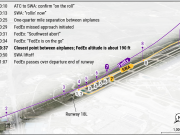The number of serious runway incursions — those that fall into Categories A or B — reported to the U.S. Federal Aviation Administration (FAA) in fiscal year 2017 declined to just eight, only three of which involved commercial aircraft, according to a recently updated FAA fact sheet on runway safety. In the previous fiscal year, FAA reported 19 serious incursions, 10 of which involved commercial aircraft. The U.S. government fiscal year runs from Oct. 1 through Sept. 30.
A runway incursion is any occurrence at an airport involving the incorrect presence of an aircraft, vehicle or person on the protected area of a surface designated for the landing and takeoff of aircraft. FAA defines a Category A incursion as a serious incident in which a collision was narrowly avoided. Category B incidents are those in which separation decreases and there is a significant potential for collision, which may result in a time-critical corrective/evasive response to avoid a collision.
The vast majority of incursions fall into Categories C and D and pose no risk of collision, FAA said.
In fiscal year 2000, FAA said there were 67 reported Category A and B runway incursions, of which 43 involved commercial aircraft. The fewest incursions in the past 18 years were reported in 2010, when there were six in Categories A and B, three of which involved commercial aircraft.
FAA said it has developed runway safety light (RWSL) technology to increase situational awareness for pilots and airport vehicle drivers. RWSL systems derive traffic information from surface and approach surveillance systems and illuminate red in-pavement airport lights to signal potentially unsafe situations. These systems include runway entrance lights, which illuminate if it is unsafe to enter or cross a runway, and takeoff hold lights that illuminate when there is an aircraft in position for departure and the runway is occupied by another aircraft or vehicle and is unsafe for takeoff.
RWSLs are operational at 18 large U.S. airports, and two more are scheduled to come online by February 2019, FAA said.

